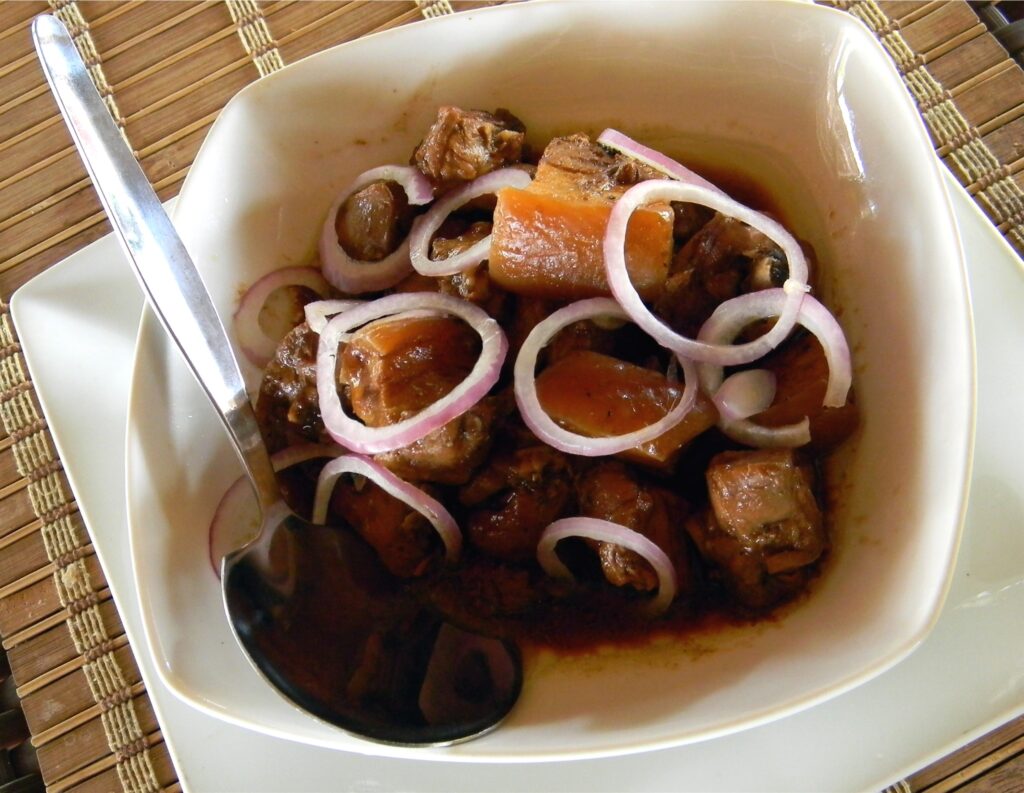ADOBO: NATIONAL FOOD OF FILIPINOS
Text and Photos by Henrylito D. Tacio
If the United States has perfectly-charred hamburgers while South Korea has the healthy and flavorful bulgogi and Hungary has their slow-cooked goulash stew, then the Philippines has the mouth-watering adobo as a national food.
Nancy Reyes-Lumen told CNN Philippines adobo should be the country’s national food “because it is easy to prepare, with many different varieties — from the choice of meat down to the sauce base.” As the chef, television host, author, and self-proclaimed “Adobo Queen” stressed: “That makes adobo so Pinoy in character.”
Like its neighboring Asian countries, the Philippines is a region of mouth-watering delights. And wherever you go outside of the country like the United States, United Kingdom, France, Canada, you hear of adobo being hailed by foreigners.

One Filipino food writer wrote: “Aside from the fact that adobo is well-loved by Filipinos, the dish also makes use of many of our local ingredients giving adobo the distinct Filipino flavor. We can give credit to the pure cane vinegar for the adobo’s rich sour taste and to the locally-produced soy sauce for its savory and salty feel. Sitaw or kangkong can also be added for a healthier alternative. For spicier versions of adobo, adding siling labuyo and recado enhances the over-all zest of the meal.”
Indeed, there’s no other Filipino dish that can compete with adobo in terms of versatility and variety. Mixing vinegar, soy sauce, and spices with either chicken, pork, fish, kangkong, or sitaw would yield to different varieties of the famous Filipino dish.
There are many ways to cook adobo. To name a few: adobo sa gata, adobong matamis, adobong tuyo, adobong masabaw, adobo sulipan, adobo sa pinya, and adobo sa kalamansi. Adobo can also fill the pandesal, siopao, and puto, be made into adobo flakes, be poured evenly into pizzas, and be mixed with spaghetti. And if those are not enough, local food companies have recently come up with adobo sauce and adobo spread.
“There are as many recipes for adobo as there are Philippine islands,” noted New York Times food columnist Sam Sifton. “If you could devote your life to traveling through (the more than 7,000 islands) asking questions about food, you would discover a different recipe for adobo on each one.”
In his column, Sifton wrote: “There is great fun to be had in asking Filipinos how to make adobo, particularly when they are in groups. Filipino cooking is an evolutionary masterpiece, a cuisine that includes Chinese, Spanish, American, and indigenous island influences, all rolled into one. But where for one Filipino the most important aspect of the dish is Spanish, for another it is Chinese, or both, or neither.”

Adobo is the result of the eclectic influences, both regional and historical, that come together in many Filipino dishes. “Philippine cooking probably reflects history more than a national cuisine,” says Cecilia Florencio, a nutrition professor at the University of the Philippines.
Or to quote one local saying: Philippine food was prepared by Malay settlers, spiced by the Chinese, stewed by the Spanish, and hamburger sized by the Americans. Adobo is all but the last.
From the northernmost stretch of islands of Batanes to the vinta-dependent islets of Tawi-Tawi, adobo is a staple cuisine along with other regional favorites like the papaitan for the Ilocanos, pinikpikan for the Ifugaos, the Bicol Express for the Bicolanos, and the kinilaw for Visayans. No wonder, the first thing most Filipinos who have been abroad requesting when they come home is adobo.
Sifton even mentions the history of adobo in his column. He pointed out: “The journalist and food historian Raymond Sokolov has made the point that the ingredients for adobo were present in the Philippines before (Ferdinand) Magellan — only the name, which comes from a Spanish word for sauce, came later. ‘Lexical imperialism,’ he called this process.”
But the main thing about adobo is that it is cooked differently. Sifton wrote: “Husbands argue with wives about adobo. Friends shoot each other dirty looks about the necessity of including coconut milk or soy sauce in the recipe. There are disputations over the kind of vinegar to use, over the use of sugar, over the inclusion of garlic, and how much of it. Some use chicken exclusively in the dish, others pork, some a combination of the two.”
For those who have not tried adobo yet, the words of Yan Susanto, an occasional online writer, is an eye-opener: “The flavor of this exquisite cuisine will certainly be liked by anyone who has tasted it the first time; they will even be asking for more after the first bite. The spicy flavor of the tenderized chicken and/or pork is so irresistible and the aroma will soothe your sense of smell and tease your taste buds.
“Adobo is usually served with rice, the staple food of the Filipinos,” added Susanto. “But most of the foreigners who visit the Philippines prefer to eat it just as it is because of its taste. In fact, most of the visitors in the country look for such great cuisine while enjoying their Philippine vacation. The good thing is, hotels in the Philippines often serve adobo during breakfast as an appetizer.”
Adobo, anyone?

